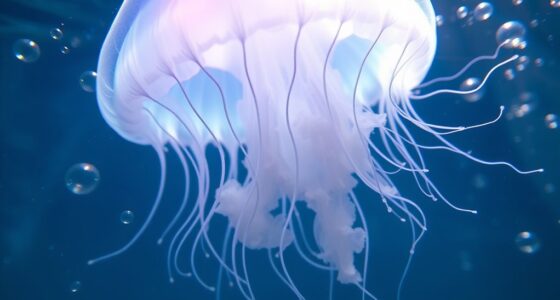Flamingos stand on one leg to conserve body heat and to showcase their vibrant plumage. This unique stance minimizes heat loss in cooler environments while also helping them maintain balance during courtship displays. Their bright feathers signal health and reproductive readiness, attracting potential mates in their colonies. So, while it might look quirky, there’s much more to this behavior than meets the eye, hinting at the complexity of their survival and social strategies.
Key Takeaways
- Flamingos stand on one leg to conserve body heat, minimizing heat loss in cooler environments.
- This posture allows them to display their vibrant plumage, attracting potential mates during courtship.
- The one-legged stance aids in maintaining balance while building nests or caring for their young.
- Bright feather coloration, linked to diet, signals health and genetic fitness to other flamingos.
- This behavior reflects evolutionary adaptations, balancing thermoregulation with social and reproductive strategies.

Have you ever wondered why flamingos often stand on one leg? It’s a sight that fascinates many, but there’s more to this behavior than meets the eye. Standing on one leg isn’t just a quirky pose; it serves practical purposes. For starters, flamingos have a unique way of conserving body heat. When they rest on one leg, they can tuck the other leg into their body, minimizing heat loss. This is especially important in cooler environments where maintaining body temperature is essential.
Flamingos stand on one leg not just for show; it helps them conserve body heat and adapt to cooler environments.
Moreover, this behavior can also be linked to their distinct feather coloration. Flamingos are famous for their vibrant pink and orange hues, which come from the carotenoid pigments in the food they consume, like algae and crustaceans. A healthy flamingo’s coloration can indicate its overall well-being and vitality. By standing on one leg, they not only maintain warmth but also display their plumage in a way that can attract potential mates. In the world of flamingos, vibrant feathers signal fitness and genetic quality, making the one-legged stance an indispensable part of their courtship rituals.
Now, let’s explore their nesting behaviors. Flamingos typically nest in colonies, building mud mounds where they lay their eggs. The construction of these nests is a communal effort, and the vibrant feather coloration plays a role here too. During mating season, the most colorful flamingos often attract partners more easily, resulting in stronger, healthier offspring. Standing on one leg while they build nests and care for their young might help them balance while they work, but it also allows them to keep a lookout for potential threats.
In essence, standing on one leg is more than just a quirky habit; it’s a behavior finely tuned by evolution. It reflects their need to conserve heat and maintain vibrant feather coloration while also being a strategic move in their nesting and mating practices. Understanding alimony types can provide insight into the complexities of their social structures. So, the next time you spot a flamingo balancing on one leg, remember that it’s not just showing off. It’s engaging in a complex dance of survival, courtship, and parenting. This simple yet fascinating behavior reveals how interconnected their physical adaptations are with their lifestyle and social structures. Understanding this can deepen your appreciation for these elegant birds and their unique way of life.
Frequently Asked Questions
Do Flamingos Sleep While Standing on One Leg?
Yes, flamingos can sleep while standing on one leg. This position helps them conserve energy and maintain stability, which benefits their hydration needs. By standing on one leg, they reduce the amount of body heat lost to the water, keeping themselves warm and hydrated. You’ll often see them balancing like this, as it’s an effective way to manage their energy while resting, ensuring they’re ready for their next activities.
How Long Can Flamingos Stand on One Leg?
Flamingos can stand on one leg for extended periods, often several hours at a time. This impressive leg stability allows them to conserve energy while resting. You might notice that they often switch legs, which helps reduce fatigue and maintains balance. By mastering this technique, flamingos can rest comfortably while staying alert to potential predators. So, when you see them balanced on one leg, remember they’re conserving energy in a smart way!
Are All Flamingo Species Known to Stand on One Leg?
Not all flamingo species are known to stand on one leg, but many do exhibit this behavior. Species variation plays a role in how often you’ll see them balancing in this way. Their habitat influence also impacts their leg positioning; for instance, in shallow waters, they might stand on one leg more frequently to conserve heat. Observing different species can reveal unique habits and adaptations tied to their environments.
What Other Birds Exhibit Similar One-Legged Standing Behavior?
Imagine saving energy while standing—sounds appealing, right? Other birds, like herons and storks, also stand on one leg, showcasing an evolutionary advantage in energy conservation. By balancing on one limb, they reduce muscle strain and maintain stability while watching for prey or resting. So, next time you see a bird doing this, remember they’re not just showing off; they’re practicing a smart survival strategy!
Can Flamingos Walk Comfortably on Just One Leg?
Yes, flamingos can walk comfortably on just one leg, though it’s less common. When they do, they rely on balance maintenance to stay upright, often shifting their weight carefully. This ability helps them conserve energy, making it easier to shift between standing and walking. While they might not look as graceful on one leg while moving, their strong muscles and intricate adaptations allow them to navigate effectively in their environment.
Conclusion
So, next time you catch a glimpse of flamingos standing on one leg, remember they’re not just showing off. They’re conserving energy while keeping a keen eye out for any potential threats. It’s a balancing act that allows them to thrive in their environment. Like they say, “If you can’t beat ’em, join ’em!” So, next time you’re feeling tired, take a cue from these elegant birds and find your own way to relax and recharge.










